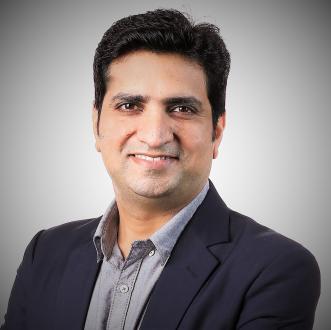DBS’ Jitendra Tekchandani on How Science and Wealth Management Expertise can Align via Client-Centricity

Jitendra Tekchandani of DBS Bank
Jan 18, 2022
Some years ago, the words ‘science’ and ‘banking'’ might never have been used in the same sentence, indeed in the same discourse. But Jitendra Tekchandani, Executive Director, Customer Science & Segment, Wealth Management at DBS Bank, believes that when the right technologies and strategies combine in the world of personal finance, the client can end up on top, and those banks that achieve such goals will then, quite naturally and organically, be the true leaders in their field. Jitendra was one of our expert panellists at the Hubbis Digital Dialogue of November 18, which addressed the highly topical subject of super-personalisation in wealth management. He was highly articulate and thorough, and as a result, we have attempted to capture his insights and observations in this summary report. DBS has very publicly set its stall out to be the leader in digital transformation and democratisation of the wealth management offering. Jitendra’s key messages were that super-personalisation is a core goal for the bank today, that client-centricity will result in better outcomes for the customers and the bank, and that few could argue the bank is not well ahead in this particular game.
The DBS digital journey began in earnest not long after the global financial crisis of 2008/9 and has had a dramatic impact on the quality and range of products and services the bank provides to wealth management clients in Asia. The powerful DBS digibank wealth platform has brought the sophisticated DBS Private Bank offerings to a far broader demographic than simply the high-net-worth and ultra-HNW clientele. The 2019-launched DBS digiPortfolio enables investors to access globally diversified portfolios with very modest initial commitments. And the current drive towards hyper-personalisation will, Jitendra told delegates on November 18, push DBS further ahead of the competition, especially through the rollout of its Client Connect. That, he explained, is a one-stop-shop to help DBS team members deliver an ever more personalised, or rather hyper-personalised approach, empowering the RMs and other frontline staff and driving intelligent wealth management.
“This whole topic is very close to our heart, and not only to me, as this is a bank-wide effort,” he reported. “But let me first be clear as to what we mean. Firstly, we do not see personalisation and hyper-personalisation as different topics; it is one topic and we are now moving from the personalisation that has a macro impact on the customer experience to the hyper-personalisation that connects more to the micro-moments of the customer.”
Four key ingredients
He explained that to realise these goals, there are four essential ingredients required. “Number one is the context,” he said, “and if there is no appropriate context, the customer feels insignificant, not see, not understood. Context is all about what a customer is thinking, how he or she is behaving, the past activity, how they have interacted with us digitally, non-digitally, what topics they have discussed with the RM, and so forth. And then, once we understand the context, then we have to find the relevance, curating products and services that are highly relevant for the customer.”
When these two elements are embedded, the bank can move to the next stage, which he says is the element of trust.
“Trust can mean different things,” he said. “Some customers are worried about the pricing, some customers are worried about the risk, some customers are worried about the product exposure, and some customers generally don’t have that knowledge about new products. To deliver that trust, we can do so digitally or through human interaction, but above all by having the empathy throughout such engagements.”
Dial DBS for intelligent banking
But none of these three elements can be attained properly entirely without data, which is the fourth element, he reported. “If you do not have the customer data at the right time, you cannot curate the right relevance and offerings,” he stated. “And that is a reason DBS has been dialling up our whole investment on intelligent banking, using AI and predictive technologies to understand the customer needs and deliver genuine super-personalisation.”
And that brought him to the recently launched DBS Client Connect platform. “It has multiple components embedded within it and is designed to overcome some shortcomings in the digital models we see out there in the market, specifically for the front-facing team members,” he explained. Because of the gaps, the RMs and advisors face hurdles, such as not having a 360-degree view of the information needed to better advise customers and the time-consuming process of pulling information together. DBS Client Connect is there to solve these problems.”
Client Connect – the next phase
He expanded on these ideas, reporting that DBS is now using AI and machine learning to nudge the RMs, not just the customers.
“We are giving them the right data, the right insights from across the bank, whether it's offline or online, and we are sharpening their advisory and service for the customer,” he told delegates. “More than that, we ask the RMs to give us feedback on each and every nudge, whether this is relevant for them or not. And it all goes into the machine learning process, and there is a gradual enhancement and elevation of the model, building better advice all the time.”
And he expanded further on the topic of data mining, explaining that the bank already has the data, so their objective is to sensitively, securely and confidentially organise and manage that data so that the right insights can be delivered to the right people internally and then the right relevance to the customers themselves, digitally or via human connectivity.
A 360-view on data insights
“Our focus is then on how to get the right insights to the customers through digital channels and make sure the RMs obtain the right insights and can then curate the right solutions for clients,” he elucidated. “And we must make sure these insights, data-driven as they are, are also there for the product creators because they can then hone their product creation to key trends in demand and interest out there. In short, the right data and insights not only help us to serve the customers, online and offline but also help us to define the new products and services for those customers.”
He explained that this is where science and banking collide to create a new world of wealth management expertise. “This approach we have taken is not a futuristic thing, it is happening today,” he said. “We are truly understanding the customers, we are connecting the dots between the offline world and the real-time digital world, and we are thereby getting deeply into the behavioural aspects of the customers.”
Building the right culture
He also tackled the issue of whether there is the right adoption internally and the right level of technical engagement. “Unless we are not focusing on the cultural part internally, this technology will not be effective,” he cautioned. He expanded on that comment, noting that, with their wealth management hat on, they are focusing more on a human-centric relationship rather than the transactional relationship, and explained that this means a shift away from a bank-driven model of selling to the customers towards the much more client-centric, entirely relevant curation and delivery of ideas, advice, products and services.
From transactional to human centric
“Transactional is the outmoded model,” he reported. “Customer centricity is key in this era of hyper personalised customer journeys. It means our first job is to understand the customer needs and we can do that by leveraging data, then providing these nudges to the RMs and advisors. And the training which we apply to attain these goals is a process we call DDOM, which is a Data Driven Operating Model, where we are talking about what outcome the customer is expecting, and that outcome is not revenue for the bank; the outcome is making the customers satisfied and making it more profitable. And it all comes back to the key driver to achieve that outcome, which is hyper-personalisation. Aligned with training and internal culture, we can harness the technology and boost adoption.”
Jitendra elaborated on the DBS-think, which he told delegates comes very much from the top down. “Throughout the bank, we think from a customer perspective, and when we do so, the rest will fall in place. And it is not only us, as this is also seen throughout many industries, where the customer is front and centre. For us, the goal is to make customers more profitable because if they are banking with us, we want to ensure they get better returns, and if we do that, we are confident the bank will then be profitable itself, as engagement and satisfaction, and activity levels will rise, we will acquire more customers, they will stay with us longer.”
Taking a fresh look at segmentation
Jitendra closed his observations by commenting that DBS is also taking a fresh look at segmentation. “The segmentation journey began some years back at DBS,” he reported. “Some of this is determined by the static components, such as name, gender, age, preferences, income, and so forth. But very importantly, much of this is dynamic, in that within a segment, people have different risk appetites or aversions, they might be savers more than accumulators, and so forth. There are different relationships with money within the segments, which are far more important than the static elements. This is why we are looking afresh at segmentation, and it all centres on behaviour.”
A great journey, in small, well-judged steps
His final comment was that DBS has, over the past decade-plus, become known as perhaps the finest digital bank in the world, and certainly within Asia. “We started slow, we didn't try to boil the ocean, and we have embraced the technology, but also evolved our culture around that,” he explained. “We have had to change our whole approach, our entire mindset, as digital adoption alone is not enough. And finally, we are doing this collaboratively, achieving goals in partnership with external providers, leveraging our capabilities and boosting the outcomes.”
And that is precisely where the inherent banking expertise and relationships combine with science and a fresh culture internally for what Jitendra believes will be a bright future for DBS.

Executive Director, Customer Science & Segment, Wealth Management at DBS Bank

More from Jitendra Tekchandani, DBS Bank
DBS Technology & Transformation Expert on the Holistic Approach to Digitisation in Wealth Management
Latest Articles






